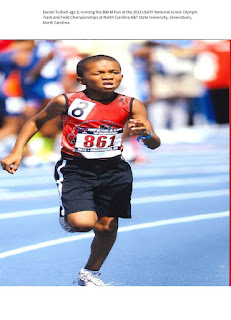Daniel Lamont Tulloch
One of the
special characteristics that the Cherokees had according to the Europeans is the
ease in which they can travel up and
down the mountains. The Cherokee
pathways was here in America way before the Europeans came.
Over the
centuries, Cherokees learn to run and move fast. This is why our DNA reflects
the fact that we in our time can move.
William Jackson Williams III (Hypo)
For example; William J. Williams III (Hypo) ran track in Jr. High and
High School. He was so good that he ran at Juniata College in Central Pennsylvania. I ran at Homeville Jr. High on the Mustang
Track Team.
So did Wyndell R. Williams.
Stephanie Ann Williams
My daughter Stephanie Ann Williams
Tulloch ran in CD Middle School and CD High School. Her and Olympic second
place Hyleas Fountain's 100 meter rely team in middle school, never lost a
race. The funny part about it is that Stephanie
is handy cap, with a turned foot at birth.
But the
greatest runner of our time was my Grandson, Daniel Lamont Tulloch, Stephanie's
son. At 8 years old, he ran the 3,000
meter run against 14 year olds and beat all but two people, (a boy and a girl
age 14).
2014
Sasquatch 5K Trail Run
May 10, 2014 Lower
Marion Meet #2
Event 2 Boys 9-10 3200 Meter Run
================================================================================
Name Year
Team Seed Finals Points
================================================================================
1 Murgia,
Charles 05
Ambler 13:18.00 10
2 walton, jonas 04
GPAL 13:22.00 8
3 Tulloch,
Daniel 05 Team
Spirit 13:30.00 6
4 Cosgrove,
Rhett 04
ASA 14:05.00 5
5 O'Kelly,
Ethan 05
Ambler 14:13.00 4
Why
didn't we keep it up? Because we found other things to do and lost interest.







